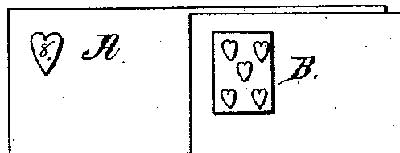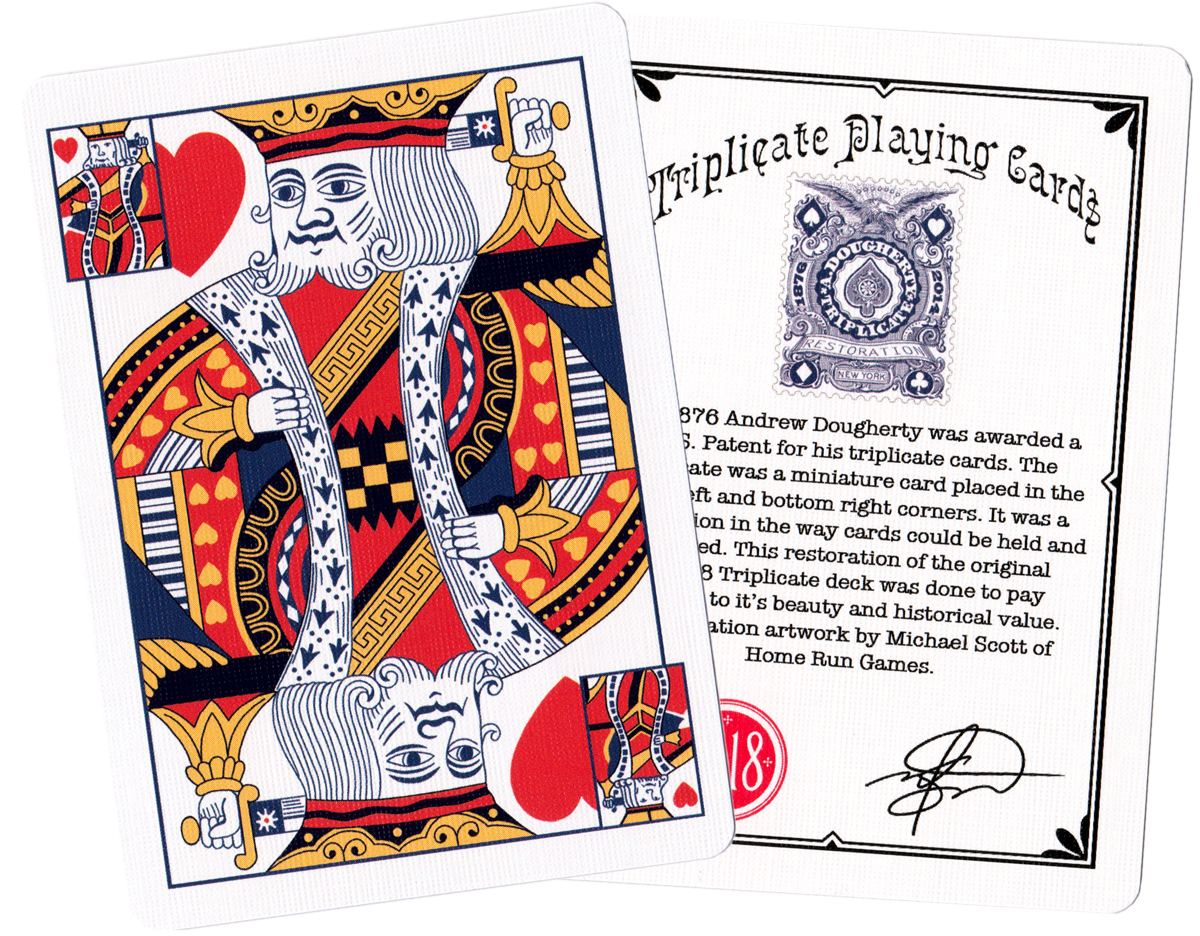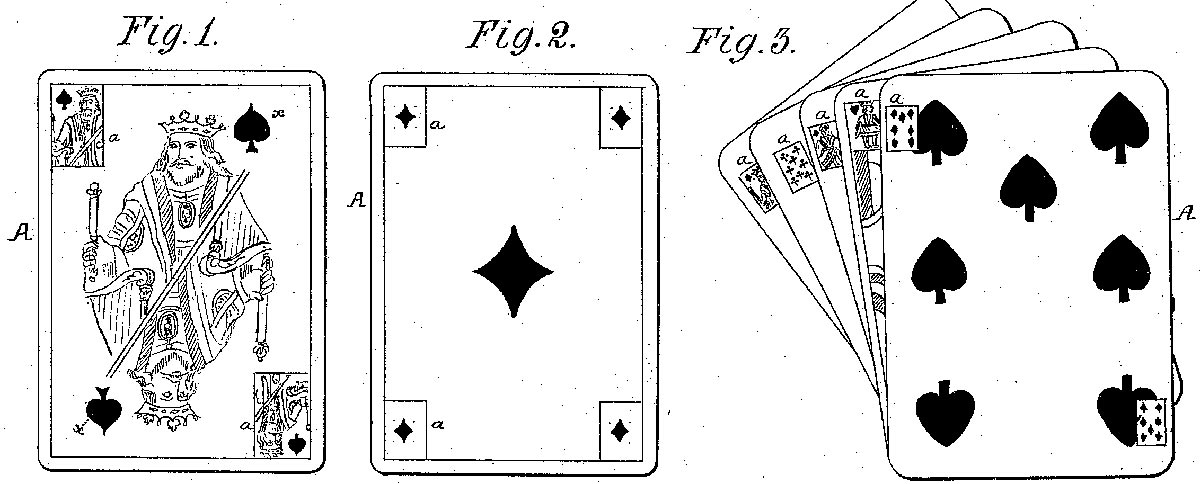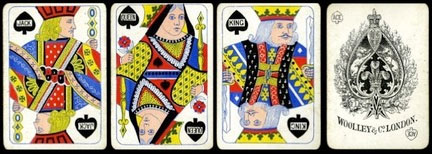Corner Indices
Corner Indices were a major innovation in playing card production.
A patent was issued on February 9, 1864 to Cyrus W. Saladee of Paducah, Kentucky, under patent number 41,587. It is believed to be the first American deck with corner indices.
“My invention consists in combining a number or letter with an emblem - such as a heart, spade, club or diamond - so that upon seeing the emblem, which may be in a corner, the denomination of the card is at once understood.”
This idea revolutionized American card manufacture by enabling players to fan the cards to view only the corner of each card, sufficient to see the indices. This was soon followed by Andrew Dougherty’s patent for “Triplicates” and other novel systems of index types which were adopted by other manufacturers until, over time, they became the new norm.
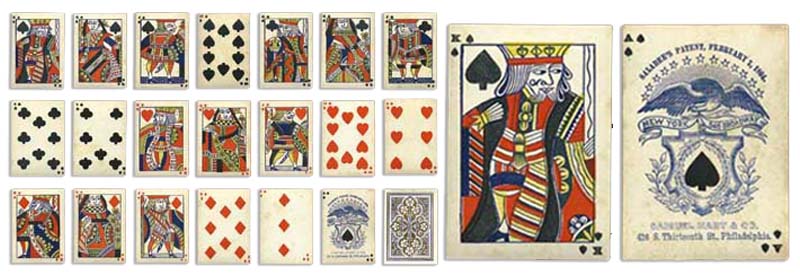
Above: Saladee's patent deck with small corner indices published by Samuel Hart, Philadelphia, 1864. The Ace of Spades mentions Saladee’s name. Hart also issued a “Bazique” set incorporating two Saladee Bazique Registers►
Triplicates
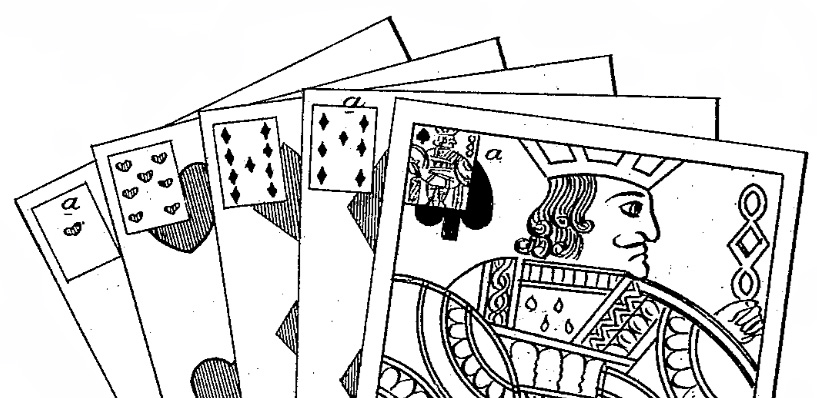
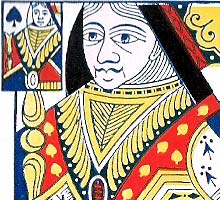 Andrew Dougherty first secured a patent for “Triplicates” in 1875, a novel type of indices with a miniature card in the top left-hand corner (and bottom right). These kept Dougherty at the forefront of innovation. There are several variations in the size and design of the “Triplicate” indices, with the smallest being the earliest. Dougherty's “Triplicates” have a specially designed Ace of Spades with a spread of cards inside the central Spade symbol demonstrating the innovation.
Andrew Dougherty first secured a patent for “Triplicates” in 1875, a novel type of indices with a miniature card in the top left-hand corner (and bottom right). These kept Dougherty at the forefront of innovation. There are several variations in the size and design of the “Triplicate” indices, with the smallest being the earliest. Dougherty's “Triplicates” have a specially designed Ace of Spades with a spread of cards inside the central Spade symbol demonstrating the innovation.
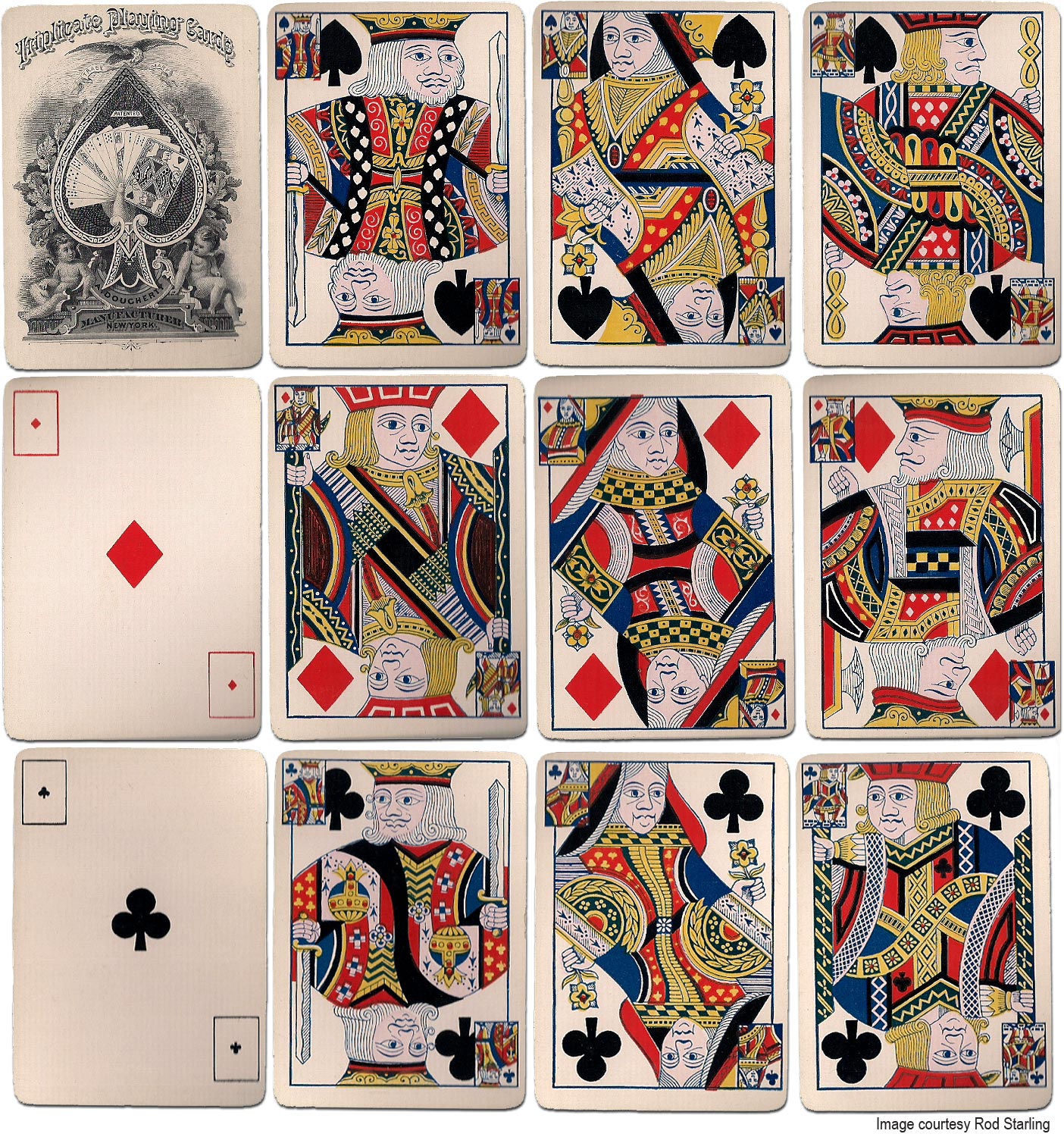
Above: Triplicate No.18' playing cards by Andrew Dougherty, c.1878. This is the second version of the brand with a 'Little Joker' card instead of a 'Best Bower' and a more elaborate Ace of Spades with the addition of two cherubs and an eagle at the top. Image courtesy Rod Starling.
In 1876, the year after Dougherty, Robert Chanony of France patented the same idea. Patent number US182166►
“The object of my invention is to improve playing-cards by rendering it possible for players to distinguish the cards in their hands without exposing them ... and this I accomplish by combining with each card one or more miniature representations thereof, as shown in the accompanying drawing.”

Above: following the lead of American manufacturers such as Dougherty and New York Consolidated Card Company, Willis & Co. introduced novel types of miniature corner indices to facilitate fanning or 'squeezing' the cards during the mid-1880s. The miniature 'triplicate' cards in the corners were apparently registered, and are ¾ or full-length figures. Interestingly the mini court indices are full length courts but Willis appeared never to manufacture full length court cards.
Indicators
Dougherty’s innovations include adding Best Bowers, Jokers, rounded corners and introducing various novel types of indices to his cards. In 1883 he was granted a patent for numbered indices, or “Indicators”, printed outside the border, along with the earlier form of “Triplicates”. It also has small breaks in the borders, as in Spanish cards, (see earlier patent for this) and these innovations helped players distinguish cards by only peeping at the corners.
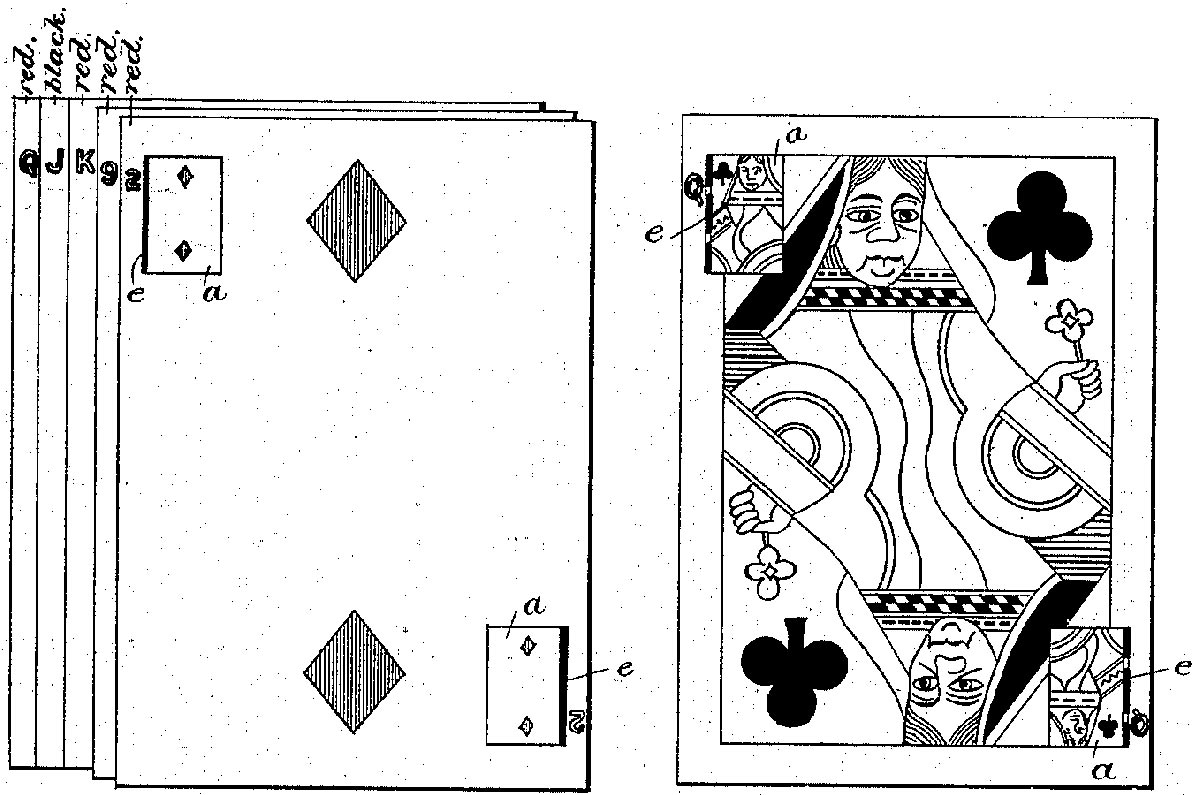
Above: details from Andrew Dougherty’s 1883 patent for Indicators see more →
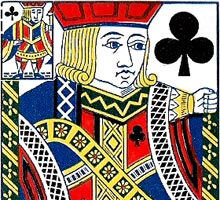
Above: “Triplicates”, the miniature cards in the corners, with little breaks in the border, which had been patented in 1876►
These “Indicators”, printed outside the border, soon became standard.
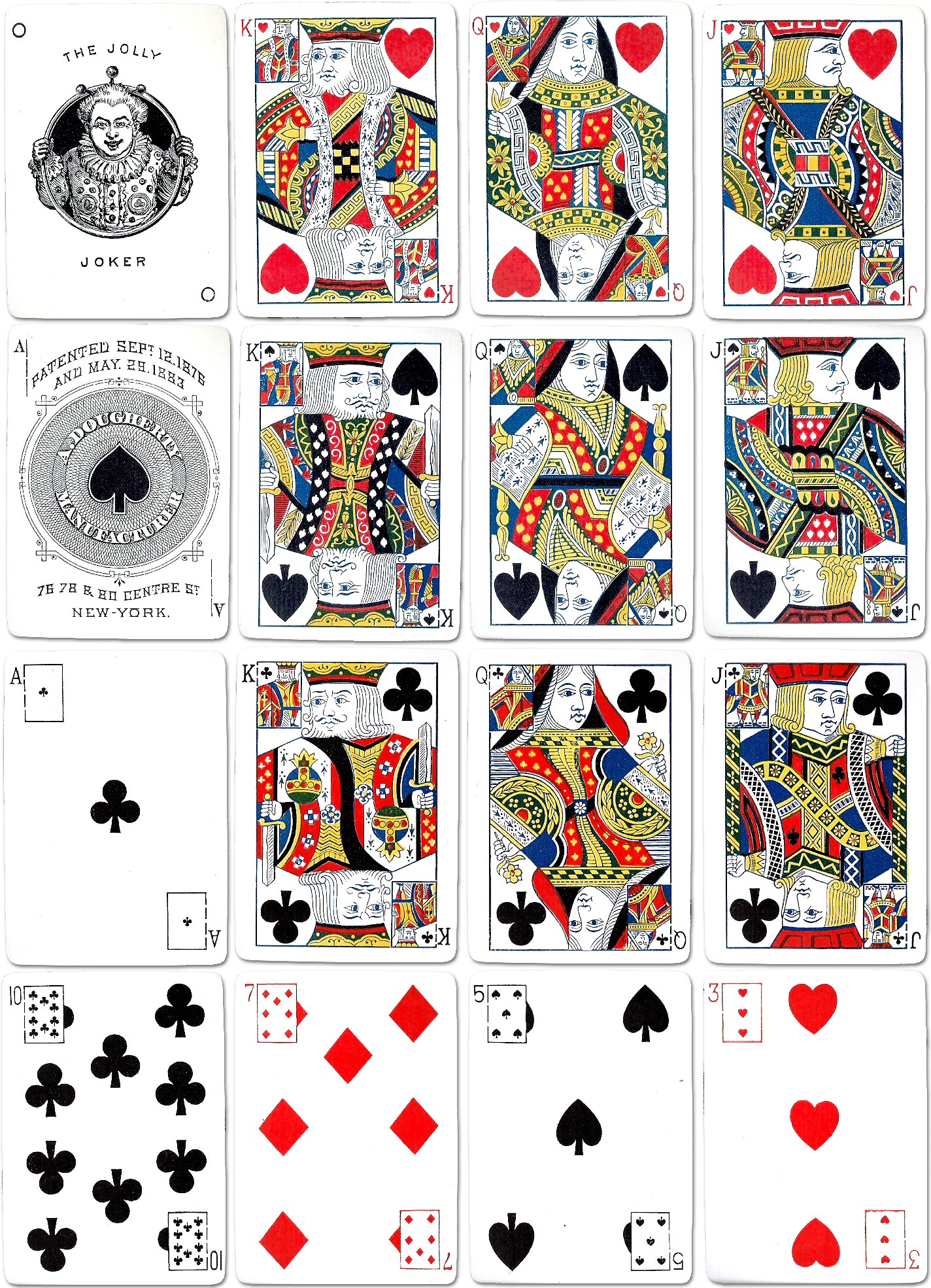
Above: Dougherty's “Ivorette No.70” deck has the “Indicator” Ace of Spades and a Jolly Joker. The Ace of Spades mentions two patents, the earlier date being for the first “Triplicate” format and the second date being for the addition of the indicator number. It was the last of the Triplicate series and incorporated the first use of numbered indices. The small margin breaks in the miniature playing cards differentiate the suits. It only ran for a year or less and was followed in 1894 by Indicators No.50. Image courtesy Rod Starling.
Many brands were issued featuring these new “Indicators”. The main distinguishing feature was the box. Brands include “Ivorette”, “Tudor”, “Tandem”, “Mogul”, “Sunset” etc.
Regarding Dougherty's “Indicator” indices that were patented in 1883, that would have been just six years after NYCCC obtained its own patent for “Squeezers”, which are more or less the same idea. It is difficult to understand what difference there was between NYCCC's “Squeezers” and Dougherty's “Indicators” that would warrant each company being granted patent rights at about the same time.
Similar new ideas were being introduced or imitated simultaneously by other manufacturers both in USA and elsewhere, with various different patented brand names, such as “Squeezers”, “Dexters”, “Eureka”, etc. so that the corner indices we now take for granted were born from these competing innovations.
The Muir & Moodie Photography Studio (1898-1916) published post cards and other photographic items documenting events in New Zealand daily life. The playing cards shown here, described on the extra card as the Greatest Novelty of the Century, feature “Triplicate” indices and corner pip arrangements on the numeral cards. The cards were printed in Bavaria (Germany) for export to New Zealand where they were sold.
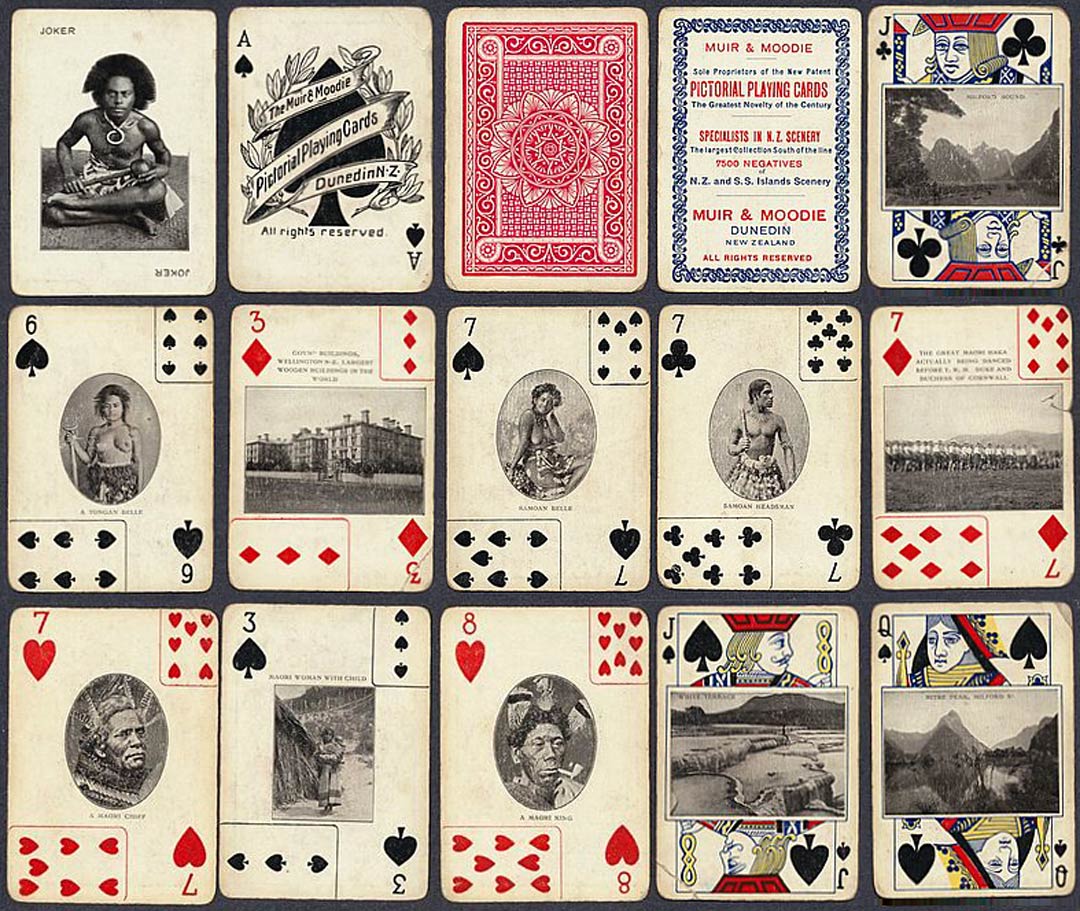
Above: The Muir & Moodie Pictorial Playing Cards, published by Muir & Moodie (1898-1916), Dunedin, New Zealand, c.1903. There was an import duty which usually has a stamp on the 2 of Diamonds. Images kindly supplied by Jack Berkus.
Dexters
The "Dexter indexes" are interesting in that the suit-signs in the corners bear a number in white upon them; the 2s and 3s have had their pips moved to accomodate this scheme. The corners of the Aces bear the outline of the respective suit, in which is the word ‘ace’. There is no marking of any sort on the Ace of Spades. The suit signs on the courts bear the letters ‘Kg’ on a King, ‘Qn’ on a Queen, and a ‘Kn’ (shorthand for "Knave") on a Jack. The original Dexter indices placed inside the corner pips had several variants: ‘Kn’ or ‘J’ for Jack; two arrangements of Aces, twos and threes; and ‘1’ or ‘ace’ on the Aces. This type of index was introduced in around 1878 and continued until c.1890. There are no jokers in this edition.
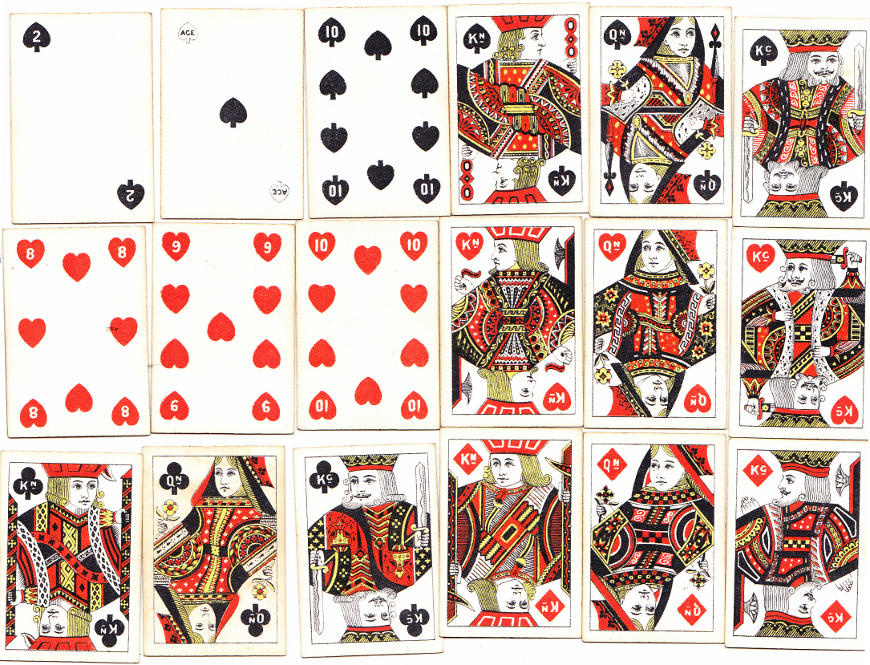
Above: 'Pigmy' miniature double-ended playing cards with 'Dexter' indices manufactured by Thomas De la Rue, c.1890. The cards measure 3 x 4.5 cms. Images courtesy Anthony Lee.
Eurekas
Packs with corner indices, along with rounded corners, had been introduced by Woolley & Co as a novelty around 1878-79 and were sold at that time for one shilling per pack. There were two versions: one with diagonal twos and threes, the other with vertical twos and threes, with small corner indices as on the ace of spades. Sometimes the AS doesn’t have an index. Both Woolley and De La Rue retained the original names for their indices after they had changed to ordinary ones. Palace Gold Dexter Moguls were still being advertised in 1931.
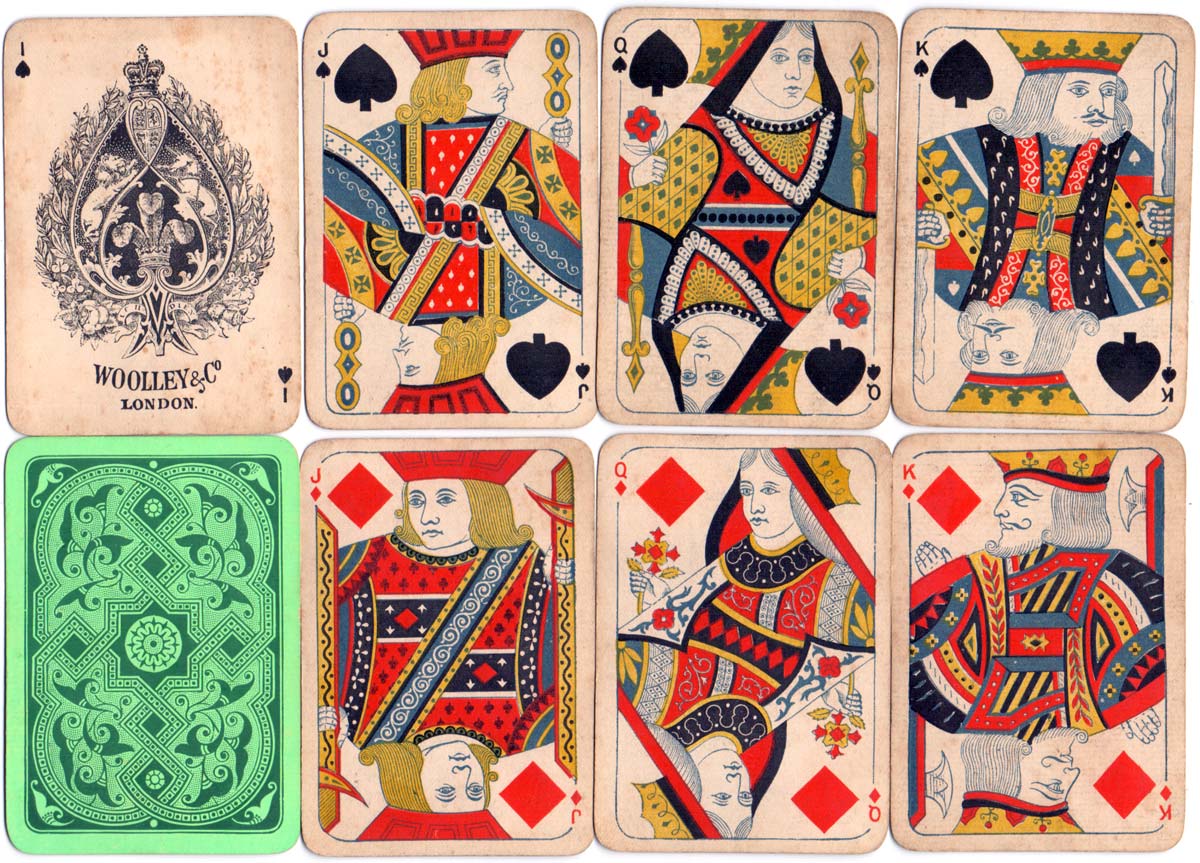
Above: Woolley & Co “Eureka” playing cards with rounded corners, small index pips and green decorative back design, c.1880-1885.

Above: very small indices with '1' for the ace, De la Rue, c.1885-1890. Courtesy Matt Probert. (Click to zoom)
Hand-drawn indices
Right: during the period c.1870-1890 indices were being introduced on playing cards. Packs are sometimes found with hand-written indices where players have improvised in interesting ways, providing documentary evidence of the days when corner indices were still in their infancy.
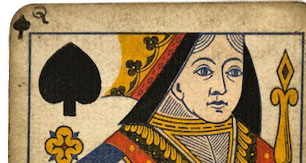
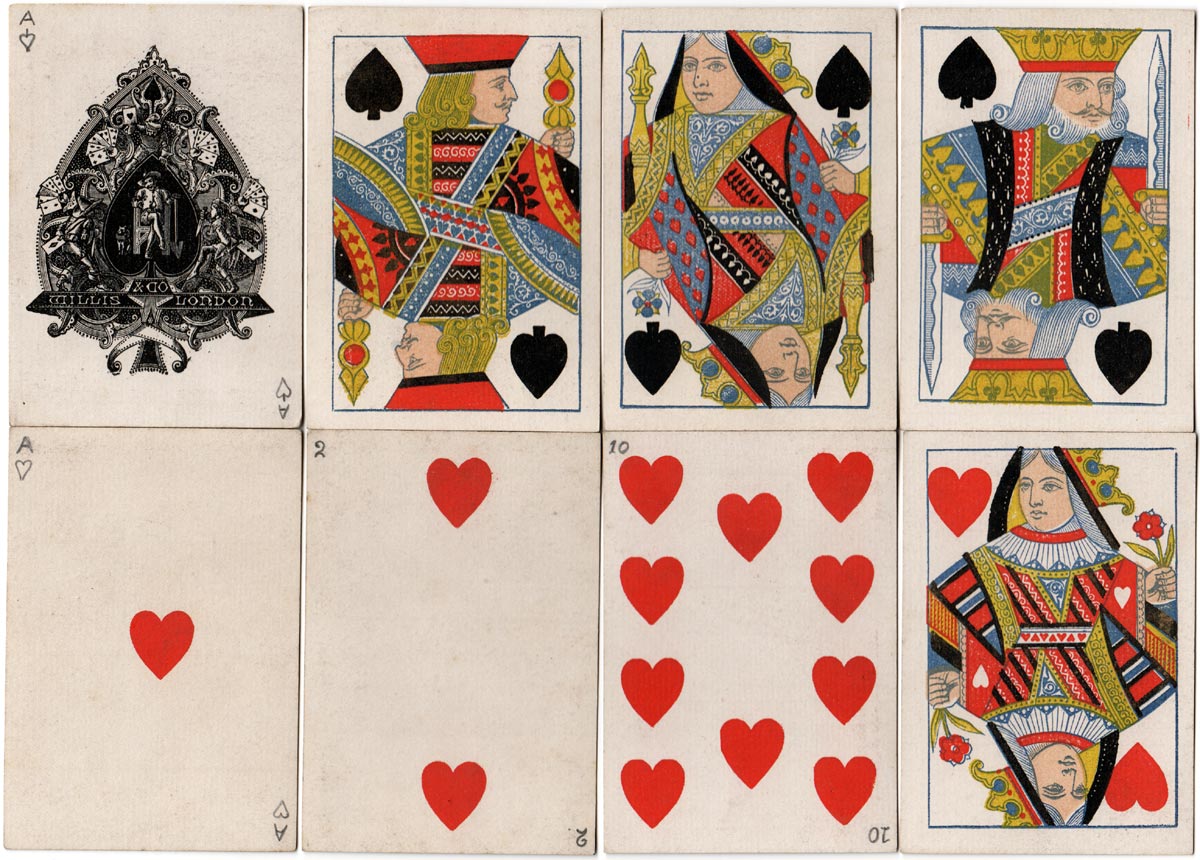
Above: cards by Willis & Co., c.1875, square corners, no indices but with small 'Eureka' indices neatly pencilled in the corners of numeral cards by a previous owner, providing documentary evidence of the days when corner indices were still in their infancy.
REFERENCES
Dawson, Tom & Judy: The Hochman Encyclopedia of American Playing Cards, U.S. Games Systems Inc., 2000
Thanks to Ken Lodge and Matt Probert for additional research.

By Simon Wintle
Member since February 01, 1996
Founder and editor of the World of Playing Cards since 1996. He is a former committee member of the IPCS and was graphics editor of The Playing-Card journal for many years. He has lived at various times in Chile, England and Wales and is currently living in Extremadura, Spain. Simon's first limited edition pack of playing cards was a replica of a seventeenth century traditional English pack, which he produced from woodblocks and stencils.
Trending Articles
Popular articles from the past 28 days
Related Articles
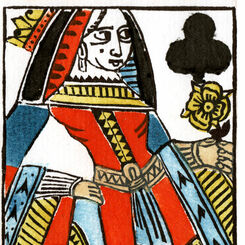
Woodblock and Stencil Queen of Clubs
A limited edition art print of the Queen of Clubs 1984 woodblock joker.
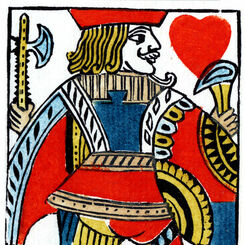
Woodblock and Stencil Jack of Hearts
A limited edition art print of the Jack of Hearts 1984 woodblock joker.
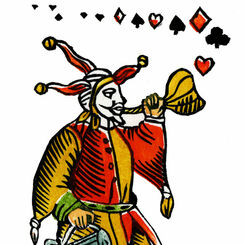
Woodblock and Stencil Joker
A limited edition art print of the 1984 woodblock joker.
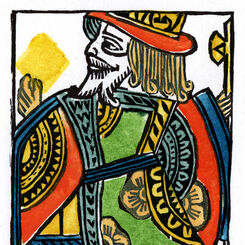
Woodblock and Stencil King of Diamonds
A limited edition art print of the King of Diamonds 1984 woodblock joker.
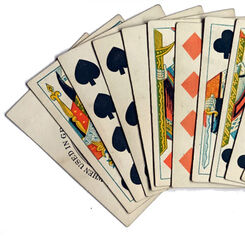
Managing cards without corner indices
For many hundreds of years cards had no corner indices, were square cut and mostly made from card wi...
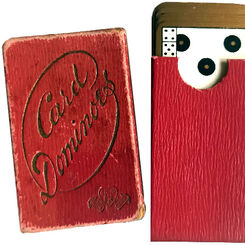
Miniature Card Dominoes
A miniature set of Goodall domino cards (5.9 x 3.5 cms) still in perfect condition.
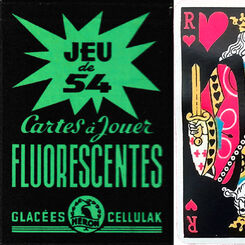
Cartes à Jouer Fluorescentes
Standard French cards but printed with fluorescent inks on a black background.
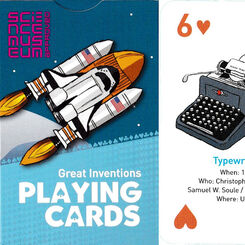
Great inventions playing cards
Great inventions playing cards designed by Gary Wyatt, United Kingdom, 2011.
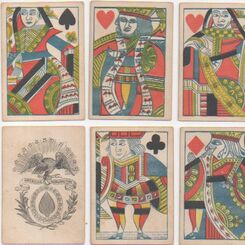
75: Early American cards
An overview of some of the early cards made in the United States.
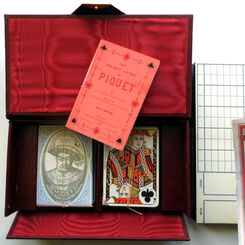
Card Game Items and contemporary advertisements
It is often difficult to identify the origin, manufacturer and date of a card game boxed set and oth...
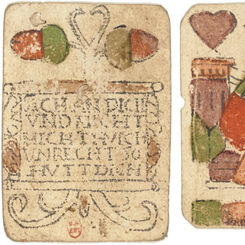
Early German playing cards
Some early examples of popular German playing cards from the XV and XVI centuries.
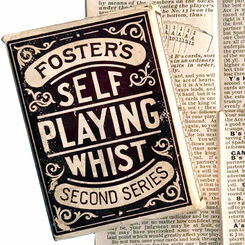
Foster’s Self-Playing Whist Cards
In 1890 R. F. Foster published the first edition of “Foster’s Whist Manual” which was to become the ...
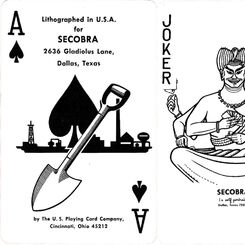
Sextet: 6 handed bridge
6 handed bridge playing cards designed by Ralph E. Peterson, 1966.
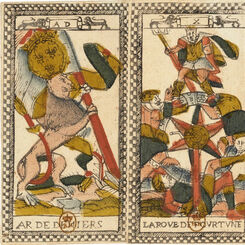
The Parisian Tarot
The “Parisian Tarot”, early 1600s, with imagery and design synthesizing several influences.
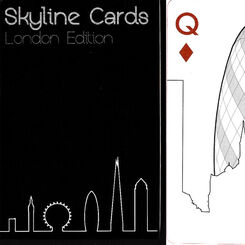
Skyline cards: London edition
Skyline cards: London edition, featuring iconic architecture, United Kingdom, c. 2018.
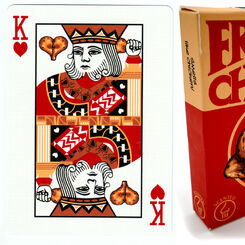
Fried Chicken Playing Cards
This innovative chicken-themed concept combines playing cards with the aroma of fried chicken.
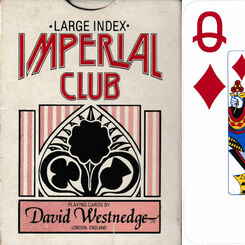
Imperial Club playing cards
Large index broad size cards by AGMüller using a special red ink suitable for casinos.
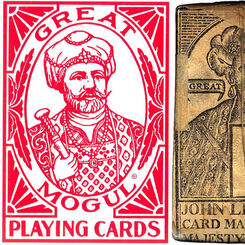
Great Mogul Playing Cards
The origins of the 'Great Mogul' brand playing cards.

Tarot of the Everlasting Day - AI Generated Tarot
Artificial Intelligence (AI) generated tarot deck produced by Marcus Katz. Is this science fiction o...
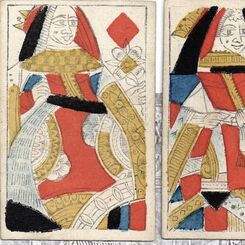
73: Fakes, Forgeries and Tax Evasion
When there are official taxes to pay, people will find a way to avoid paying them - often illegally....
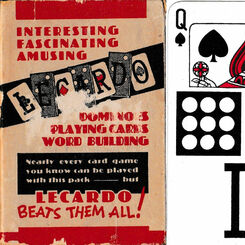
Lecardo
‘Lecardo’ playing cards, dominos & word building game invented by Stanley Kermode, United Kingdom, c...
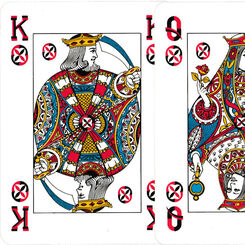
Il Quinto Seme
An Italian pack with a fifth suit of “amici” (“friends”).
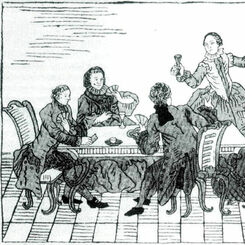
Russian Playing Card History - From the Beginnings to 1917
An in-depth review of the history of card-playing, gambling, legislation, manufacture and taxation o...
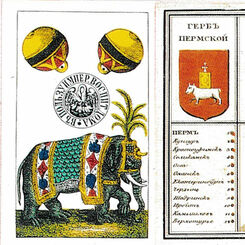
Russian Playing Card Monopoly
The Russian Playing Card Monopoly was established in March 1798 with all revenue going to support th...
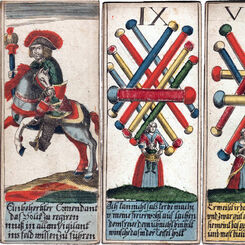
Trappola cards from Prague
15 Trappola playing cards possibly made by Johann Ziser of Prague, c1760.
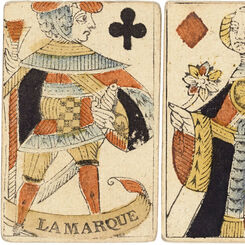
Languedoc pattern
The old Languedoc pattern was known at the beginning of the seventeenth century, if not before.
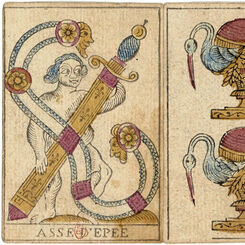
Pierre Roiné Aluette
Archaic form of Aluette published by Pierre Roiné, Nantes, c.1785.
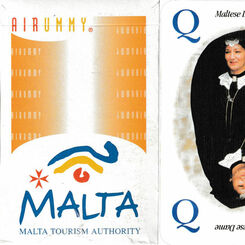
Airummy
Souvenir pack made for the Malta Tourism Authority, Malta, c.2000.
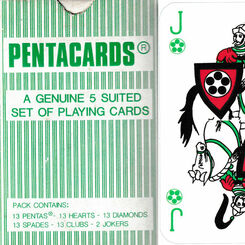
Pentacards
A five-suited set of playing cards published by Fleet and Case Games Ltd., Rainham, Kent, UK, c.1980...
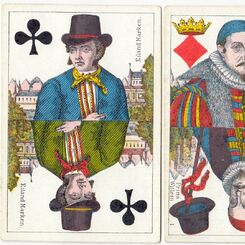
Dutch costume playing cards from an unknown maker
Another pack of Dutch costume playing cards c.1880.
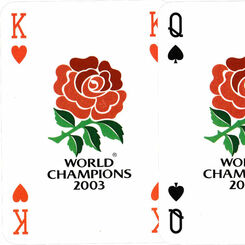
Official England Rugby Playing Cards
Pack celebrating the rugby world champions of 2003. Produced by MMcardz.
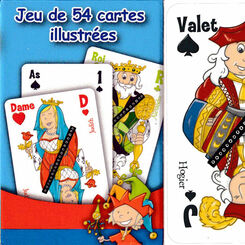
Cartes Illustrées
Standard French designs adapted for children. Made by France Cartes for La Grande Récré, c.2016.
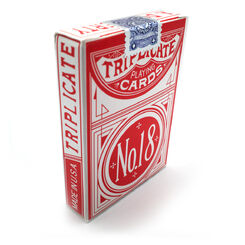
A. Dougherty’s Triplicate Recreation
A recreated of the original 1876, No. 18, Triplicate deck by A. Dougherty by Michael Scott in 2014. ...
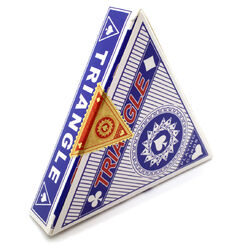
Triangle Playing Cards
Triangle Playing Cards by Michael Scott.
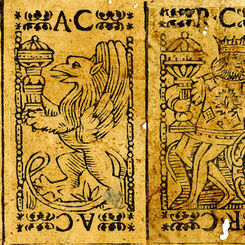
Portuguese-suited cards
Portuguese-suited cards with dragon aces, made in Italy, 1613.
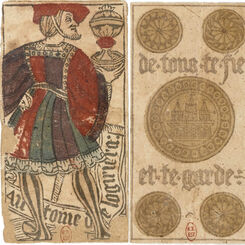
Antoine de Logiriera
Archaic Spanish-suited playing cards published in Toulouse by Antoine de Logiriera (1495-1518).
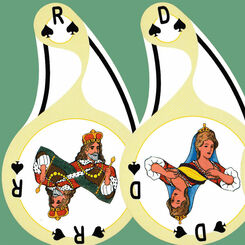
Ergomia
Complete re-design of traditional pack into what the publishers considered to be ergonomically effic...
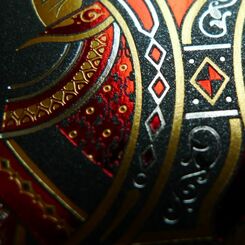
Luxury Collectable Playing Cards
Luxury packs of cards have been produced since the 15th century, a trend that is very popular among ...
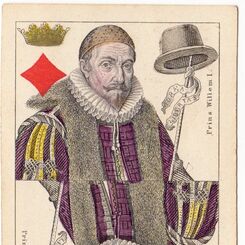
Dutch costume playing cards
Dutch costume playing cards made for the Dutch market in the second half of the 19th century.
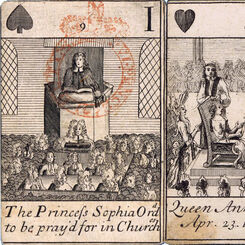
Royal Cards Reign of Queen Anne
“Royal Cards Reign of Queen Anne” cover historical events, both honourable and treacherous, during t...
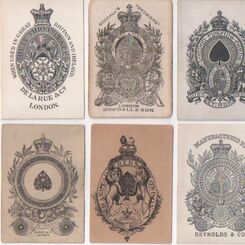
72: The Ace of Spades
In standard English packs the Ace of Spades is associated with decorative designs. This is a histori...
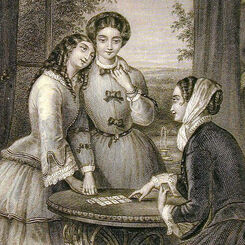
Cartomancy, Oracle and Divination Cards
Playing cards are used for fortune-telling, predicting the future or even as a psychological adjunct...
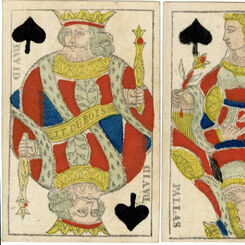
Dubois
Dubois card makers from Liège in the Walloon Region of Belgium.
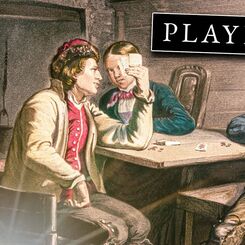
Playing Cards: A Secret History
Playing Cards: A Secret History


